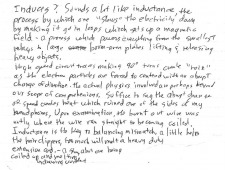|
| > iacl.org > Twisted Pair
Twisted Pair |  | |
Twisted Pair and Impedance Mismatch.
It's generally understood that to have a circuit do anything a return line is necessary - they say - for current to flow.
However this is not necessarily true. Radio amplifiers transmit electricity without any sort of return. In this application the source, line and load have been specially tuned to have the same impedance. (50 and 75 ohm coaxial cables) When matched to an antenna cut to the specific length to accommodate the frequency being sent along. The transmitted power travels along the coaxial conduit and expends itself through the antenna and into space effectively with no loss and no "standing wave" along the conduit.
In network wiring as well as printed circuit boards, no such consideration is taken hence, in the case of network lines, return wires are required, the tighter the wind the higher the frequencies attainable. Why not wind them all? it takes more wire to twist a pair and if you ever tried to do it not an easy process.
In the case of digital electronic circuits bus, from a paper I read while with the Industry, a ghost signal follows the bus signals as they go from component to component. Not being impedance balanced this phenomenon contributes to what we call "cross-talk" and the dreaded "noise floor" of any computer motherboard. This floor prevents the Industry from attaining digital signal logic much below 1 volt. (The lower the voltage to produce digital ones and zeros the less power required. Less Power, less heat.
While designing circuit boards, I took this into consideration, adding copper to unused spaces on my 2 sided board around and under or over digital bus traces. This copper was connected to ground, the 5 volt supply or nothing at all and put into production. The result? we noticed a reduction in the ground floor compared to previous versions of the circuit board.
Why leave the copper on the board? If not for the above stated reason the etching process that removes copper in the production of one's circuit board requires chemicals that lose their potency over time and become one of the industry's dreaded source of contaminated waste. AFAIK there is no easy or good way to treat this stuff other than stuff it into 55 gallon drums and store it somewhere.
Getting back to network twisted pair, it is our presumption that perhaps the tighter the winding of the twisted pair the closer they are to each other and balance producing less airborne transmission of cross talk to other bundles in the same conduit. Twisting the cord on electric clippers may have likewise been done to help induce the return current to stick to the correct path and not stray onto the possibly grounded subject the metallic clipper head would have been in contact with.
Induces? Sounds a lot like inductance, the method by which one "slows" down electricity by making it go in loops which sets up a magnetic field which powers everything from the smallest relay to boom arm plates lifting and releasing heavy objects.
Digital circuit traces making 90 degree turns generate "noise" as the electron particles are forced to contend with an abrupt change of direction. (The actual physics involved are perhaps beyond our scope of comprehension) Suffice to say that abrupt changes of direction generate heat which ruined one of the side of my headphones. Upon examination, the burnt out wire was exactly where the straight wire went into the coil.
In Conclusion Inductance is the key to balancing mismatch. Some twisting in the hair clipper cord helps. Too much melts a heavy duty extension cord too much of which had been left coiled and drawing heavy current.
|
|
|

